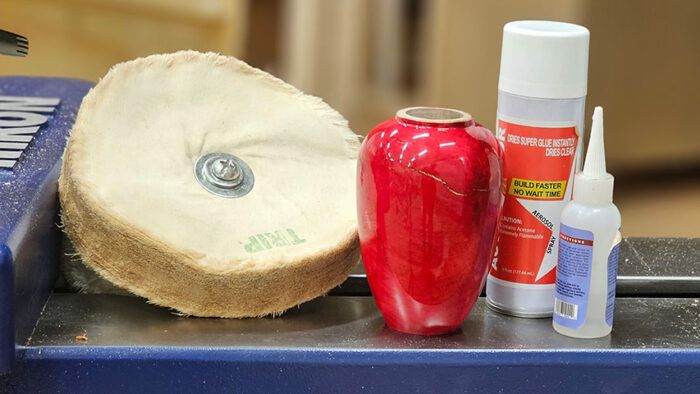How to get a glass-smooth surface on turnings
Darryl Jones shares valuable tips for achieving a flawless CA finish on wood-turned projects.
A high-gloss shine can be the perfect way to finish your latest wood-turned masterpiece, but it can also be difficult and time consuming to achieve. However, CA (cyanoacrylate) glues can be your path to a relatively quick and easy glassy smooth surface. I have used CA to finish both large and small items including pens and full-size urns. Here are a couple of quick tips to getting a great CA finish on your next turning.

Use the right gloves so that you don’t end up with pieces of your gloves or applicators glued to your fingertips. Food-service gloves are made of HDPE (the same material that CA bottles are made of) and CA will not stick to it. These gloves are also referred to as “poly gloves.”
As with any finish, surface prep is important with some special considerations for CA. Fill all voids first because the finish will be applied while turning using a paper applicator. Rough edges around voids can snag and tear little bits of paper from the applicator, which can get stuck in your finish. This is an opportunity to embellish your piece with particulates such as turquoise, brass filings, mica powders, etc. Fill the void in layers, a little particulate followed by thin CA, then activator, and repeat until the void is slightly overfilled. Then sand it flush.

Use activator sparingly! Apply a few coats of thin CA (usually two) then a quick spritz of activator followed by one more coat. At this point, inspect the surface for any inconsistencies. If there are issues, sand the surface until smooth (this will aid smooth adhesion of successive coats). If there are no issues, proceed to add several more coats one after the other without activator. I usually apply a total of 12. You want a relatively thick layer of finish to make flattening the surface easier.
Flatten the surface by wet sanding with a fine grit (usually anywhere from 320 to 800) until the surface is uniformly dull; the shiny spots are the low areas. This step is very important. The secret to a glass-smooth surface is a very flat topcoat, nothing else matters. Excessive sanding between coats and excessive use of activator are not necessary or desired.

Once the surface has been sufficiently flattened, the item can be taken to a buffing wheel. I use the Beall brand buffing wheels using the tripoli compound followed by white diamond compound. If done correctly, this technique will reward you with a spectacular “glass-dipped” finish with very little distortion.

 |
Finishes: Our favorite articlesOur editors have sorted through our archives for their favorite articles and videos on finishing |
 |
Video: A sunburst finish for bowlsWood turner Michael Allison answers questions about his colorful trademark finish at the 2006 Fine Furnishings Show |
 |
From the archive: Fill the grain for a glass-smooth finishSimple steps are key to success with pore fillers |
Fine Woodworking Recommended Products

Odie's Oil


Waterlox Original





















Log in or create an account to post a comment.
Sign up Log in